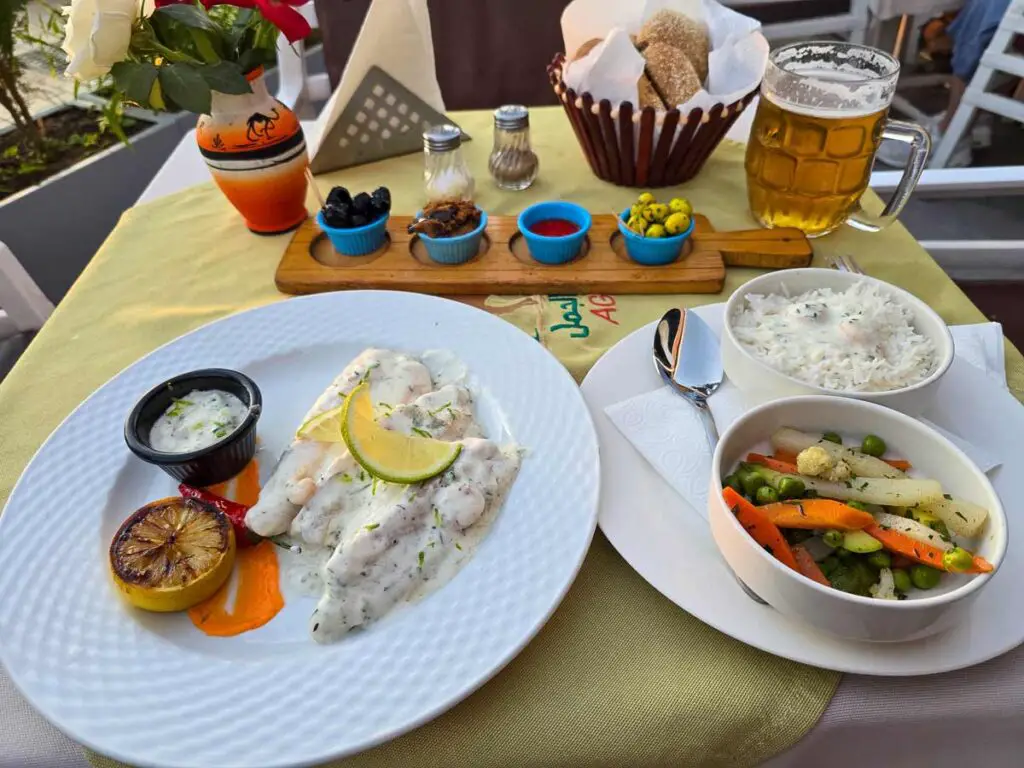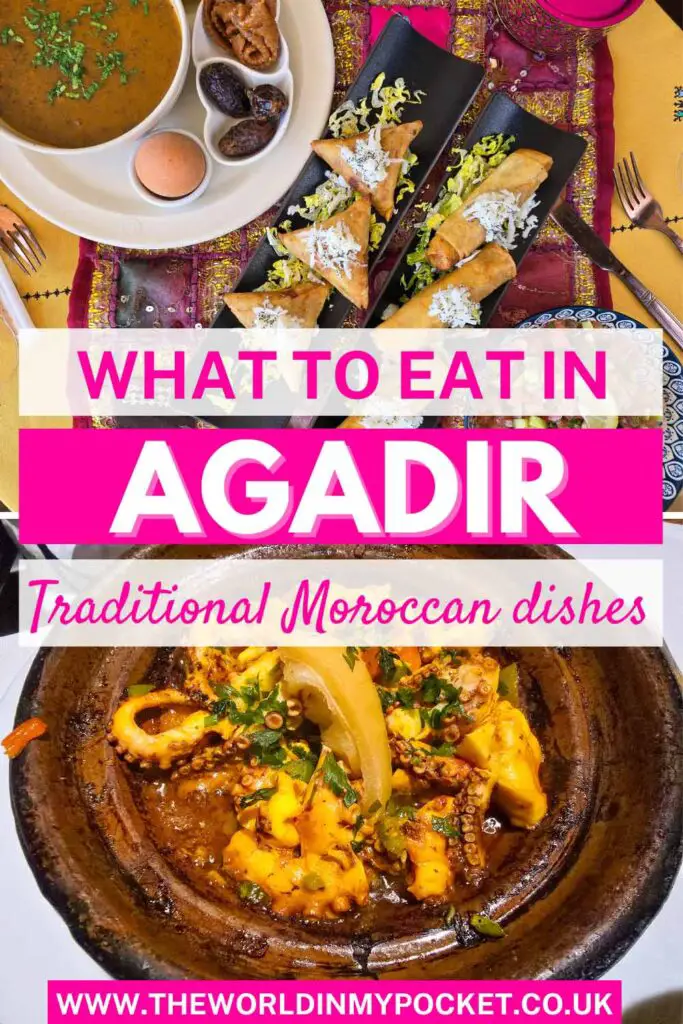When I first arrived in Agadir, I wasn’t expecting a culinary sensation. My plan was simple: unwind by the beach, switch off, and take a proper break from the day to day life. But, as it always happens when I travel, food found its way into the centre of everything.
I’ve travelled up and down Morocco before—Marrakech, Fes, Casablanca, Chefchaouen—you name it. I thought I had a good grasp on what Moroccan food was all about. But when it comes to what to eat in Agadir, the city showed me a different side. This sun-soaked coastal city has its own rhythm, its own personality, and most importantly—its own flavour. Here, the cuisine dances around the ocean, with seafood so fresh it feels like it jumped straight from the waves onto your plate. There’s argan oil drizzled like liquid gold, zesty chermoula that punches through with herbs and citrus, and of course, the ever-present tagines that are adapted to the abundance of fish in the ocean.
This guide isn’t a list of everything you could eat in Agadir—because frankly, we’d be here for days—but rather a celebration of what I tried and loved. The dishes that stuck with me, the ones I went back for seconds (or thirds), and the flavours that still make me smile when I think about them.
The Cuisine in Agadir

One of the biggest surprises during my time in Agadir was how different the local cuisine felt compared to the rest of Morocco. While I expected more of the same—slow-cooked tagines, fluffy couscous, and fragrant spices—what I discovered instead was a beautiful, fresh, and simple way of eating, centred almost entirely around the ocean.
Agadir is all about fish. Freshly caught, grilled, baked in sauce, or gently spiced and stuffed into tagines—seafood takes centre stage here. Even the air is salty, and the food matches the mood: light, bright, and full of flavour. Whether it’s John Dory in a creamy prawn sauce or sardines marinated in chermoula, you can taste how close the ocean is with every bite.
A star ingredient in the region is argan oil—and no, not the stuff you use in your hair, although it’s technically the same. Here, it’s culinary gold. With a rich, nutty flavour, argan oil is used in certain dishes – especially my beloved amlou. But we will talk about amlou a bit later on.
There’s something quite special about where argan oil comes from. Argan trees only grow along Morocco’s southwestern coast—this is the only place in the world where you’ll find them. Driving outside the city, you’ll see the trees scattered across the hills. Most of the oil is still made the traditional way, often by women working in small cooperatives who pass the method down through generations.
So, if you’re in Agadir and wondering what to eat—start with the sea, and don’t skip the argan oil.
What to Eat in Agadir
Now that we’ve set the scene with what makes Agadir’s cuisine so special, let’s get into the real reason you’re here: the food itself. From rich tagines to fresh-off-the-boat fish, these are the dishes that I ate my way through Agadir with, one bite at a time. Some are comforting classics I looked forward to every day, others were complete surprises—but each part of this sunny puzzle of Agadir, this laid-back city by the ocean.
Harira Soup

One of the most memorable dishes I had in Agadir was harira, a comforting Moroccan soup that’s traditionally served during Ramadan. I actually visited Agadir during the holy month, and everywhere I turned, locals shared stories about how this dish holds a special place at their iftar table — the meal that breaks the fast each evening. While you might find harira elsewhere in Morocco, in Agadir it felt especially tied to this time of year.
Harira is a rich, tomato-based soup thickened with lentils, chickpeas, and sometimes rice or broken vermicelli noodles. It’s seasoned with warming spices like ginger, cinnamon, and turmeric, and often finished with a handful of fresh herbs — usually parsley and coriander — to lift the whole thing.
What made it feel like a real event, though, was how it was served: with a soft-boiled egg on the side, a couple of sticky-sweet dates, and a traditional Moroccan sweet called chebakia — a deep-fried sesame cookie twisted into an intricate flower shape, soaked in honey and sprinkled with sesame seeds. The contrast between the spiced, savoury soup and the chewy sweetness of the chebakia is something I didn’t know I needed until I tried it.
Sardines with Chermoula

One dish that completely stole my heart in Agadir was the sardines with chermoula. Chermoula is a classic Moroccan marinade made with a fragrant mix of fresh coriander, parsley, garlic, lemon juice, paprika, cumin, and olive oil — though in Agadir, it’s often blended with a splash of argan oil too, which adds a subtle nuttiness. There are many ways to use chermoula: sometimes it’s rubbed on top of whole fish before grilling, other times it’s used as a base for tagines. But my favourite version was the stuffed sardines, where the herby marinade is generously tucked between two fillets before they’re lightly pan-fried.
The portion I got was absolutely enormous — five plump sardines, perfectly cooked, and served with a side of tomato salad, rice, and wedges of lemon. The price? Just under 50 dirhams. A complete bargain. There was so much flavour packed into something so simple. The freshness of the herbs in the chermoula paired beautifully with the richness of the sardines, cutting through that natural oiliness and lifting every bite.
Monkfish

Now, if you live in the UK like me, you probably know that monkfish is one of those fancy, premium fish that usually comes with a hefty price tag attached. But in Agadir, it’s a whole different story. Monkfish is not only easy to find, but it’s also incredibly affordable, which honestly still surprises me every time.
The best way to enjoy monkfish, in my opinion, is to keep it simple. Just grilled, with a good squeeze of lemon over the top — that’s all it really needs. I ordered the monkfish tail, and when it arrived, I couldn’t believe my eyes. It was absolutely massive — practically spilling over the edges of the plate — and served with grilled vegetables and rice on the side.
It was exactly what I wanted: meaty, full of flavour, and cooked just right, with a slight char that gave the outside a little smoky bite while keeping the inside soft and juicy. It’s the kind of dish that lets the freshness of the fish shine — no bells and whistles, just good cooking and great ingredients.
If you’re a seafood lover, monkfish in Agadir is a must. Your tastebuds (and your wallet) will thank you.
John Dory

John Dory — or as it’s called on pretty much every menu in Agadir, Saint Pierre — is one of those fish you’ll see everywhere, and for very good reason. It’s a local favourite, and once you try it, you’ll understand why.
The most popular way it’s cooked here is with a rich prawn sauce, and oh my, what a pairing that is. The fish itself is incredibly delicate, with a soft, almost buttery texture that just melts in your mouth. And then there’s the sauce — a creamy, slightly sweet concoction that clings to the fish and packs so much flavour, you’ll want to mop every last drop up with some bread.
It usually comes already portioned, so you’re not fiddling around with bones or skin — just enjoying a beautifully cooked piece of fish smothered in prawns and goodness. It’s a dish that feels indulgent, yet light at the same time. If you only try one fish dish in Agadir, let it be this one. Trust me.
Couscous Royal

In Morocco, couscous is a sacred Friday ritual — and many restaurants only serve it on that day. So if you’re craving it mid-week, you might be out of luck. But if you find yourself in Agadir on a Friday, do yourself a favour and try the Couscous Royal — just make sure you’re really hungry.
I made the classic mistake of ordering it without knowing what I was getting into. Spoiler alert: this is not your regular bowl of couscous. It’s a mountain of food, topped with a generous helping of everything. We’re talking tender lamb that falls apart with the touch of a fork, juicy beef koftas, skewered chicken, and even sausages. It’s a proper feast, and it’s not holding back.
It also comes with a rich, spiced sauce that you pour over the top, making it even more comforting and indulgent. The couscous itself is light and fluffy, soaking up all that flavour beautifully.
Moral of the story? If you’re ravenous, Couscous Royal will make your day. If you’re just a little peckish… maybe share it. Or cancel your evening plans and prepare for a nap.
Octopus Tagine

Now this was a bit of a surprise — I don’t think I’d ever seen octopus in a tagine before, but I was instantly intrigued. The dish came out bubbling away in a rich tomato sauce, packed with sweet red peppers and that signature Moroccan depth of flavour.
Cooking octopus is no small feat. As anyone who’s ever had a rubbery bite knows, it can so easily go wrong. But here? Perfectly tender. The octopus had soaked up all that gorgeous sauce and was melt-in-your-mouth soft, not a hint of chewiness in sight.
It was such a clever, innovative way to cook octopus, blending Moroccan tradition with something just a little unexpected. I honestly loved every bite.
Fish Tagine

A classic done right, the fish tagine in Agadir is everything you’d hope for — comforting, full of flavour, and bursting with freshness. It usually features a whole white fish or hearty chunks of it, simmered gently in a lemony chermoula marinade, surrounded by potatoes, peppers, tomatoes, olives, and a handful of spices that make the sauce sing.
The best ones I had came to the table still bubbling in their clay pot, the aroma alone enough to make your mouth water. The fish was always perfectly flaky, falling apart with just a nudge of the fork, having absorbed all those delicious, zesty, herbaceous notes.
What I loved most was how light yet satisfying it felt — a dish that leaves you full, but not heavy. Served with Moroccan bread to mop up every last drop of that sauce… it’s a must-try when you’re by the coast.
Shrimp Pil Pil

When I saw shrimp pil pil on the menu in Agadir, I immediately assumed it would be the same as the Spanish gambas pil pil — sizzling prawns cooked in olive oil, garlic, and chilli, served still bubbling in their little clay dish. Well… I was wrong. Very wrong.
The Moroccan version couldn’t be more different. Here, shrimp pil pil is a comforting, rich tomato-based dish, with lots of tiny shrimp swimming in a fragrant, slightly spicy sauce. The only thing it has in common with the Spanish version is the brown clay-style bowl it’s served in.
That said, I really enjoyed it. Topping the crowd of shrimp was a surprise full prawn, and I was absolutely not complaining. The tomato sauce was so good I couldn’t resist mopping it all up with bread — not a drop was wasted.
Amlou

I could honestly write an entire love story—or maybe a collection of passionate sonnets—dedicated to amlou. It’s that good. If you’ve never tried it, think of it as Morocco’s answer to Nutella, but a thousand times better (and healthier, too).
Amlou is a silky, rich blend of roasted almonds, honey, and argan oil, ground into a luscious paste that’s nutty, slightly sweet, and just the tiniest bit earthy from the argan. Every spoonful tastes like it’s been made with love—and that’s probably because it has. Amlou is almost always homemade, and while you can buy it in the markets, it’s never mass-produced. So don’t ask me how I brought it back home, on the plane, after I left Agadir, because it was an entire saga!
I had it every single morning without fail, slathered generously over mesmen, the buttery, flaky Moroccan flatbread. It was my moment of bliss before the day started. If you’re ever in Agadir, please, do yourself a favour and try it—but be warned: one taste and you’re hooked for life.
For more similar articles about Agadir, check out my recommendations below:
Like it? Pin it!

Disclaimer: Some of the links on this website are “affiliate links.” This means that if you click on the link and do a purchase, I will receive an affiliate commission at no extra cost for you. This helps me keep my website running and continue to share my travelling knowledge with you. I thank you for booking your flights or hotels using the links on my website. Regardless, I only recommend products or services I use personally and believe will add value to my readers.





Great read! The monk fish looks delicious 🤤
I love the honesty of this post.. food recs are my favorite posts and I appreciate your honest feedback